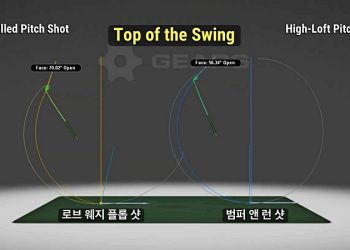드라이버샷의 방향을 평면상에서 보면 9가지로 분류할 수 있다. 목표를 중심으로 왼쪽으로 날아가는 것 세 가지, 목표 쪽으로 날아가는 세 가지, 목표보다 오른쪽 향하는 세 가지 샷이다. 이들 샷의 최종 목적지는 모두 다르다. 이중 목표 방향으로 향하는 세 가지는 드로우샷, 페이드샷 그리고 스트레이트 샷이다.
페이드샷은 볼이 목표 방향보다 왼쪽으로 날아가다가 오른쪽으로 휘어져 원하는 타깃에 도달하는 샷을 말한다. 클럽 패스는 out-to-in 으로 만들어진다. 임팩트 순간의 페이스 앵글은 클럽 패스보다 덜 닫혀있어야 한다.
이러한 각도의 차이로 임팩트가 되면, 볼은 왼쪽으로 날아가다가 오른쪽으로 휘어진다. 임팩트 순간에 만들어진 볼의 스핀에 의해서 오른쪽으로 휘어지는 것이다.
페이드샷을 3차원 공간에서 보면, 다시 두 가지로 구별할 수 있다. 탄도가 상대적으로 낮고 거리가 짧은 일반적인 페이드샷은 행온(Hang-on) 페이드샷이라 한다. 반면에 볼의 탄도가 더 높고 더 멀리 나가는 샷은 파워 페이드(Power Fade) 샷이라고 한다. 월드 그레이트 2탄에 출연한 피터 코스티스는 파워 페이드샷의 요령을 다음과 같이 표현한다.
“파워 페이드샷은 훅 샷을 치는 것처럼 클럽을 돌려주지만 훅의 구질이 나오지 않는 것을 말한다. 파워 페이드샷을 구사하기 위해서는 두 가지가 중요하다. 첫째는 손목이 자연스럽게 회전 릴리스 되어야 한다. 릴리스를 할 수 있다면 훅 구질의 볼을 칠 수 있다.
파워 페이드를 치기 위해서 훅을 치는 것처럼 릴리스하면서 왼쪽 골반을 매우 빨리 돌려준다. 하체를 강하게 고정한 후에 샷을 이어가면 볼은 왼쪽으로 날아갈 수 없다. 즉 하체가 파워 페이드샷을 할 수 있게 하는 것이다. 손목의 동작에 의존했던 기존의 페이드샷과 근본적으로 다르다.”
파워 페이드 샷은 다운스윙을 강하고 빠르게 하는 것이 중요하다는 얘기다. 그러려면 왼쪽 골반과 왼쪽 다리를 빠르게 회전시켜야 한다. 오른쪽 다리도 같이 밀어낸다. 하체를 빠르게 열어서 클럽 페이스가 스퀘어 상태가 되게 하는 것이 열쇠다. 다시 정리하자면, 손으로 릴리스하면서 하체를 더 빨리 회전시키는 것이다.
동영상에서 파위 페이드샷을 직접 시연한 전영인 선수의 드라이버 샷을 비교해 본다. 먼저 시도한 샷은 일반적인 페이드샷이다. 이때 클럽 패스는 -0.9(out-t -in)로 만들어졌다. 거리는 236야드였다.
두 번째 시도에서는 클럽 패스가 0.7(in-to-out)으로 나왔다. 거리는 251야드로 첫 번째 페이드샷보다 15야드 더 멀리 갔다. 세 번째에선 245야드였는데 이 역시 일반 페이드샷보다는 더 멀리 나갔다. 전영인 선수의 평소 드라이버샷의 구질인 드로우샷과 거의 비슷한 거리를 만들어 냈다.
파워 페이드샷을 만들어 내기 위해서는 강한 하체가 스윙의 축이 바탕이 되어야 한다. 샷을 자유롭게 만들어 내는 샷 메이킹을 효과적으로 하기 위해서는 강한 체력을 함께 준비해야 한다.
☞ 전욱휴는…
골프 칼럼니스트. PGA 클래스A 멤버이자 공인 티칭 및 코칭 강사다. SBS, MBC, JTBC, YTN 등의 골프 채널에서 진행자 및 해설자로 활약했다. 현재 애틀랜타에서 골프 레슨 및 골프 관련 비즈니스를 하고 있다. chungolf@gmail.com
[Dr.Eric Chun’s Golf Lesson] 13.
“Hit a power fade shot farther and straighter!
Release with both hands while rotating the lower body faster.
• The direction of a driver shot can be categorized into nine types when viewed on a plane. There are three types of shots that fly to the left of the target, three types that fly towards the target, and three types that fly to the right of the target. The final destinations of these nine types of shots are all different. However, a draw shot, fade shot, and straight shot head towards the target.
Among these, a fade shot is a shot where the ball curves to the right after initially heading left of the target. The ball reaches the desired target. The club path is created out-to-in. At the moment of impact, the face angle must be less closed than the club path. When the impact happens with this difference in angles, the ball flies left and then curves to the right. It’s a shot that curves to the right due to the spin imparted on the ball during impact.
When viewed in three-dimensional space, a fade shot can be further divided into two types. A shot with relatively lower trajectory and shorter distance is called a hang-on fade shot. In contrast, a shot with higher trajectory and longer distance is called a power fade shot.
Peter Kostis, featured in World Greats 2, describes how to hit a power fade shot as follows:
“To hit a power fade shot, you turn the club as if you’re hitting a hook shot, but the ball does not follow a hook trajectory. To execute a power fade shot, you need to do two things. First, the wrists must naturally rotate and release. If you can release, you can hit a ball with hook trajectory. To hit a power fade, release as if hitting a hook and rotate the left hip very quickly. If you keep the lower body firmly anchored while continuing the shot, the ball cannot fly to the left. In other words, the lower body enables the power fade shot. This is fundamentally different from conventional fade shots that rely on wrist action.”
When hitting a power fade shot, make the downswing strong and fast. Rotate the left hip and left leg quickly. Push off with the right leg as well. Open the lower body quickly to keep the clubface square.
In summary, Peter Kostis’ power fade shot is achieved by releasing with the hands while rotating the lower body faster.
Let’s compare a shot demonstrated on broadcast by professional golfer Yeong-in Jeon. The first attempted fade shot was a typical fade shot. The club path was -0.9 out-to-in. The distance was 236 yards. The second driver shot attempted by Jeon had a club path of 0.7 in-to-out. The distance was 251 yards, 15 yards farther than the fade shot. The third attempted power fade shot covered 245 yards, farther than the typical fade shot, and nearly matched the distance of a draw shot, which is Jeon’s usual driver shot.
To create a power fade shot, a strong lower body that serves as the axis of the swing is essential. Strong physical fitness is also necessary for effective shot-making that allows you to freely create shots.”




![[전욱휴의 골프 레슨] 13. 파워 페이드샷](https://www.atlantajoongang.com/wp-content/uploads/2024/06/collage-5-750x563.jpg)

















![[전욱휴의 골프 레슨] 46. 배치기(얼리 익스텐션)](https://www.atlantajoongang.com/wp-content/uploads/2025/03/photoKakaoTalk_20250306_073237889_01-350x250.jpg?v=1741361116)
![[전욱휴의 골프 레슨] 45. 임성재 '행온페이드' 샷](https://www.atlantajoongang.com/wp-content/uploads/2025/02/collage1-350x250.jpg)
![[전욱휴의 골프레슨] 44. 일관된 샷을 원한다면](https://www.atlantajoongang.com/wp-content/uploads/2025/02/QKakaoTalk_20250212_065748485-350x250.jpg)

![[전욱휴 골프 레슨] 42. 오른쪽 팔꿈치 역할](https://www.atlantajoongang.com/wp-content/uploads/2025/01/qQ1KakaoTalk_20250130_072058648-350x250.jpg)
![[전욱휴의 골프 레슨] 41. 매킬로이 파워 스윙](https://www.atlantajoongang.com/wp-content/uploads/2025/01/qQ1KakaoTalk_20250122_123635940-350x250.jpg)
